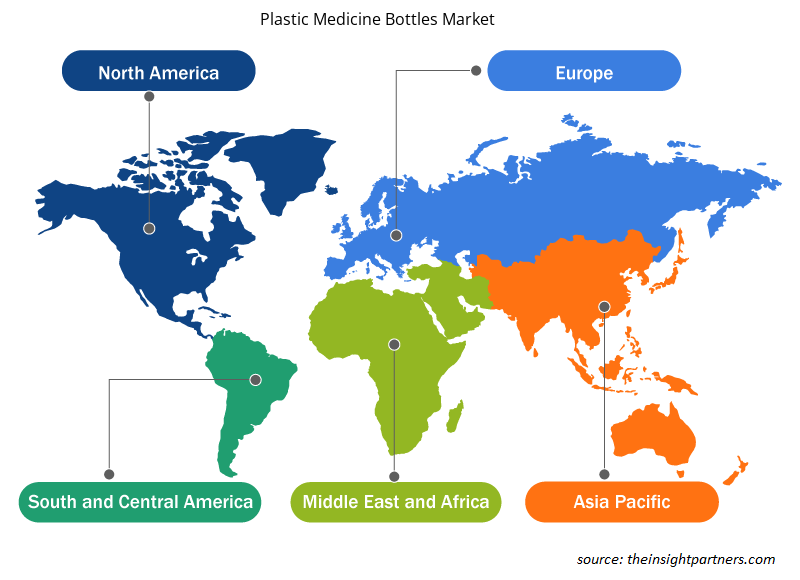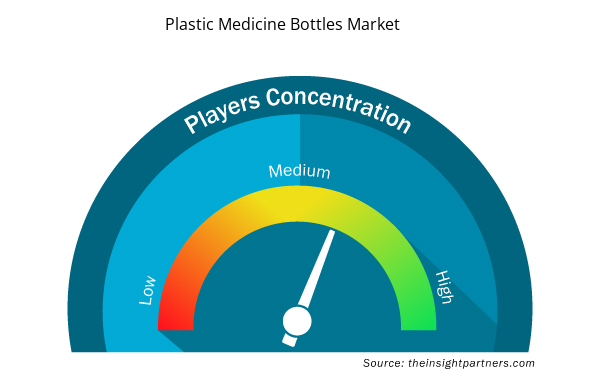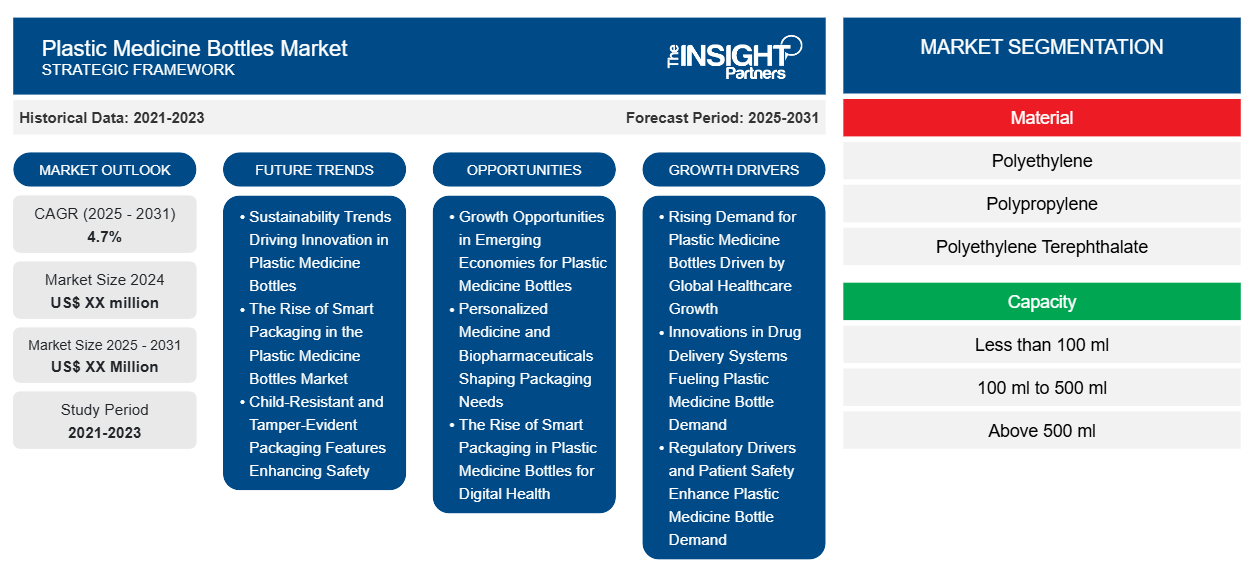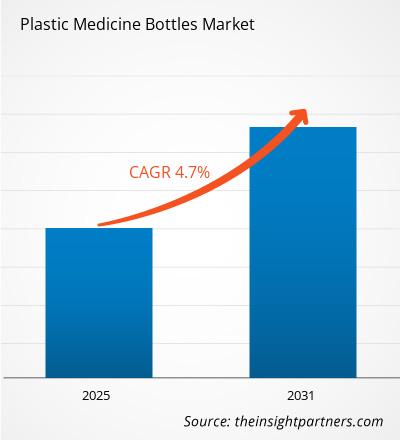Si prevede che il mercato dei flaconi di plastica per medicinali registrerà un CAGR del 4,7% dal 2023 al 2031, con una dimensione di mercato in espansione da XX milioni di dollari nel 2023 a XX milioni di dollari entro il 2031.
Il report è segmentato per materiale (polietilene, polipropilene, polietilene tereftalato, cloruro di polivinile e altri). Il report è ulteriormente segmentato per capacità (meno di 100 ml, da 100 ml a 500 ml e oltre 500 ml). Il report è segmentato per tipo di prodotto (flacone contagocce, flacone spray nasale, flacone per l'igiene orale, contenitori solidi e altri). L'ambito del report copre cinque regioni: Nord America, Europa, Asia Pacifico, Medio Oriente e Africa e Sud e Centro America e paesi chiave in ciascuna regione. L'analisi globale è ulteriormente suddivisa a livello regionale e nei principali paesi. Il report offre il valore in USD per l'analisi e i segmenti di cui sopra.
Scopo del rapporto
Il report Plastic Medicine Bottles Market di The Insight Partners mira a descrivere il panorama attuale e la crescita futura, i principali fattori trainanti, le sfide e le opportunità. Ciò fornirà spunti a vari stakeholder aziendali, come:
- Fornitori/produttori di tecnologia: per comprendere le dinamiche di mercato in evoluzione e conoscere le potenziali opportunità di crescita, consentendo loro di prendere decisioni strategiche informate.
- Investitori: condurre un'analisi completa delle tendenze in merito al tasso di crescita del mercato, alle proiezioni finanziarie del mercato e alle opportunità esistenti lungo la catena del valore.
- Enti di regolamentazione: regolamentano le politiche e le attività di controllo sul mercato allo scopo di ridurre al minimo gli abusi, preservare la fiducia degli investitori e sostenere l'integrità e la stabilità del mercato.
Segmentazione del mercato delle bottiglie di plastica per medicinali
Materiale
- Polietilene
- Polipropilene
- Polietilene tereftalato
- Cloruro di polivinile
Capacità
- Meno di 100 ml
- Da 100 ml a 500 ml
- Oltre 500 ml
Tipo di prodotto
- Flacone contagocce
- Flacone spray nasale
- Bottiglia per l'igiene orale
- Contenitori solidi
Geografia
- America del Nord
- Europa
- Asia-Pacifico
- America del Sud e Centro
- Medio Oriente e Africa
Geografia
- America del Nord
- Europa
- Asia-Pacifico
- America del Sud e Centro
- Medio Oriente e Africa
Personalizza questo report in base alle tue esigenze
Riceverai la personalizzazione gratuita di qualsiasi report, comprese parti di questo report, o analisi a livello nazionale, pacchetto dati Excel, oltre a usufruire di grandi offerte e sconti per start-up e università
- Scopri le principali tendenze di mercato in questo rapporto.Questo campione GRATUITO includerà analisi di dati che spaziano dalle tendenze di mercato alle stime e alle previsioni.
Driver di crescita del mercato delle bottiglie di medicinali in plastica
- Domanda crescente di flaconi di medicinali in plastica guidata dalla crescita dell'assistenza sanitaria globale: la crescente domanda in tutto il mondo di prodotti farmaceutici, farmaci da banco e integratori per la salute richiede la produzione di massa di flaconi di medicinali in plastica in tutto il mondo. Le prescrizioni, così come i farmaci da banco, stanno principalmente guidando la domanda di flaconi di medicinali in plastica durante l'attuale fase di domanda crescente innescata dall'aumento della popolazione globale, dall'invecchiamento demografico e dalle malattie croniche. Liquidi farmaceutici, compresse e capsule sono ampiamente confezionati in flaconi di medicinali in plastica per la loro durata, economicità e facilità d'uso. A causa della crescita del settore sanitario, una crescente domanda di imballaggi efficaci e sicuri per i medicinali continua a essere una tendenza primaria nel mercato dei flaconi di medicinali in plastica.
- Innovazioni nei sistemi di somministrazione dei farmaci alimentano la domanda di flaconi di plastica per medicinali: le innovazioni nei sistemi di somministrazione dei farmaci, come i farmaci liquidi e orali, hanno anche aumentato la domanda di flaconi di plastica per medicinali. Oltre all'espansione nei sistemi di formulazione e somministrazione dei farmaci, le aziende farmaceutiche si stanno anche concentrando sulle bottiglie di plastica come mezzo di confezionamento per determinati tipi specifici di farmaci nell'area di specializzazione. I flaconi di plastica per medicinali hanno acquisito maggiore accettabilità per il confezionamento non solo di farmaci orali ma anche di altri farmaci liquidi che richiedono un elevato livello di barriera contro umidità e ossigeno per prevenire la degradazione dei farmaci durante il confezionamento, lo stoccaggio e la consegna.
- I driver normativi e la sicurezza dei pazienti aumentano la domanda di flaconi di plastica per medicinali: alcuni dei principali driver del mercato dei flaconi di plastica per medicinali includono alti livelli di pressione normativa sulle aziende farmaceutiche per garantire la sicurezza, l'integrità e la tracciabilità dei prodotti. I governi e le agenzie di regolamentazione in tutto il mondo, dalla FDA e dalla Food and Drug Administration statunitense all'Agenzia europea per i medicinali, richiedono imballaggi antimanomissione e chiusure a prova di bambino per i prodotti farmaceutici. Tali caratteristiche sono sempre state incluse nei flaconi di plastica per medicinali. Sarebbero utili per soddisfare le normative, la sicurezza dei pazienti e anche contro la contraffazione. Questa tendenza normativa spinge ulteriormente la domanda di imballaggi in plastica sicuri e protetti nel settore farmaceutico.
Tendenze future del mercato delle bottiglie di medicina in plastica
- Tendenze di sostenibilità che guidano l'innovazione nei flaconi di plastica per medicinali: lo scenario della sostenibilità è emerso di recente come l'ultima tendenza nel mercato dei flaconi di plastica per medicinali. La consapevolezza ambientale tra i consumatori sugli effetti dannosi della plastica sta spostando l'attenzione delle aziende farmaceutiche verso un sostituto migliore in termini di soluzioni di imballaggio sostenibili. Più che mai, i produttori stanno producendo flaconi di plastica per medicinali riciclabili in PET. Inoltre, l'uso di plastiche biodegradabili, accompagnato dalla crescita diffusa di materiali ecocompatibili per tappi ed etichette per flaconi, si sta sviluppando in modo significativo. Questo cambiamento verso la sostenibilità è in linea con le preferenze dei consumatori, aiutando al contempo le aziende farmaceutiche a soddisfare gli standard regionali e internazionali sulla gestione dei rifiuti di plastica.
- L'ascesa degli imballaggi intelligenti nel mercato delle bottiglie di plastica per medicinali: le aziende farmaceutiche richiedono l'innovazione di imballaggi a prova di bambino e antimanomissione sul mercato, e questo ha dato origine alla creazione di un certo tipo di bottiglie di plastica per medicinali che incorporano proprietà di imballaggio a prova di bambino e antimanomissione. Si sta dando sempre più importanza alla sicurezza dei pazienti e alla prevenzione dell'ingestione accidentale di medicinali da parte dei bambini, e quindi le chiusure a prova di bambino e i sigilli antimanomissione stanno diventando sempre più importanti. Queste caratteristiche vengono sempre più introdotte nell'imballaggio di farmaci da banco, vitamine e farmaci da prescrizione in bottiglie di plastica, il che sta guidando nuove dimensioni di innovazione e differenziazione nei design degli imballaggi. Il mercato per tali soluzioni si espanderà anche con normative di sicurezza più severe.
- Caratteristiche di imballaggio a prova di manomissione e a prova di bambino che migliorano la sicurezza: una tendenza emergente per il mercato dei flaconi di plastica per medicinali, basata su una domanda sempre più crescente di soluzioni per la salute digitale e l'aderenza ai farmaci, è stata identificata come imballaggio intelligente. Qui, si prevede lo sviluppo di flaconi di plastica intelligenti con sensori integrati, codici QR o tag RFID per aiutare a tracciare l'utilizzo, monitorare la gestione dell'inventario e fornire avvisi di promemoria al paziente. Queste soluzioni di imballaggio "connesse" aiutano gli operatori sanitari e i pazienti a garantire che qualsiasi farmaco a cui ci si aspetta l'aderenza venga seguito in modo efficace e che, di conseguenza, i risultati generali del trattamento siano migliorati. Anche il crescente utilizzo di tecnologie di telemedicina e monitoraggio della salute spinge l'utilizzo di imballaggi intelligenti; le aziende farmaceutiche sono ora desiderose di infondere strumenti digitali nella loro offerta.
Opportunità di mercato per le bottiglie di medicinali in plastica
- Opportunità di crescita nelle economie emergenti per i flaconi di plastica per medicinali: le economie emergenti nelle regioni Asia-Pacifico, America Latina e Africa hanno grandissime opportunità di crescita nel mercato dei flaconi di plastica per medicinali. C'è un forte aumento della domanda di soluzioni di imballaggio per medicinali in queste regioni perché un migliore accesso all'assistenza sanitaria e un maggiore consumo di prodotti farmaceutici hanno portato a questa tendenza. Questa tendenza è guidata dalle popolazioni emergenti della classe media, dalla crescente consapevolezza della salute e dagli investimenti fatti dai governi nelle infrastrutture sanitarie. Le aziende possono penetrare in questi mercati in crescita attraverso la localizzazione, le partnership con aziende farmaceutiche regionali e imballaggi a basso costo che attraggono i consumatori sensibili al prezzo.
- Medicina personalizzata e prodotti biofarmaceutici che modellano le esigenze di imballaggio: la medicina personalizzata e i prodotti biofarmaceutici continuano a essere cambiamenti di tendenza nelle condizioni delle bottiglie di plastica per medicinali. In generale, i prodotti biofarmaceutici come biologici, vaccini e terapie geniche richiedono un imballaggio specifico, che fornisca un'adeguata stabilità e protezione del prodotto. Tali ruoli si adatterebbero quindi alle bottiglie di plastica, che hanno proprietà di barriera migliorate. Allo stesso modo, la medicina personalizzata potrebbe consistere in dosaggi più piccoli o persino individualizzati che possono essere facilmente riempiti in bottiglie di plastica per medicinali più piccole. I produttori sarebbero quindi interessati a discutere opportunità di partnership con aziende biofarmaceutiche nello sviluppo di soluzioni di imballaggio personalizzate per i nuovi tipi di farmaci.
- L'ascesa degli imballaggi intelligenti nei flaconi di plastica per medicinali per la salute digitale: la convergenza digitale tra tecnologie sanitarie e imballaggi farmaceutici presenta un'opportunità per l'adozione di flaconi di plastica per medicinali, in particolare quelli con soluzioni di imballaggio intelligenti. Il sistema può tracciare meglio i medicinali, il dosaggio e l'aderenza rendendo i flaconi di plastica abilitati con sensori, NFC o tecnologia Bluetooth. Ciò è molto rilevante per la gestione delle malattie croniche, in cui i pazienti devono assumere i medicinali prescritti in modo routinario e molto routinario. Con l'aumento della domanda di soluzioni digitali correlate alla salute, l'introduzione di funzionalità intelligenti nei flaconi di plastica per medicinali sarà una delle vie di crescita più promettenti per i produttori che sono interessati all'innovazione e all'aggiunta di valore agli imballaggi tradizionali.
Approfondimenti regionali sul mercato delle bottiglie di medicinali in plastica
Le tendenze regionali e i fattori che influenzano il mercato delle bottiglie di medicina in plastica durante il periodo di previsione sono stati ampiamente spiegati dagli analisti di Insight Partners. Questa sezione discute anche i segmenti e la geografia del mercato delle bottiglie di medicina in plastica in Nord America, Europa, Asia Pacifico, Medio Oriente e Africa e America meridionale e centrale.

- Ottieni i dati specifici regionali per il mercato delle bottiglie di plastica per medicinali
Ambito del rapporto di mercato sulle bottiglie di medicina in plastica
| Attributo del report | Dettagli |
|---|---|
| Dimensioni del mercato nel 2023 | XX milioni di dollari USA |
| Dimensioni del mercato entro il 2031 | XX milioni di dollari USA |
| CAGR globale (2023-2031) | 4,7% |
| Dati storici | 2021-2022 |
| Periodo di previsione | 2024-2031 |
| Segmenti coperti | Per materiale
|
| Regioni e Paesi coperti | America del Nord
|
| Leader di mercato e profili aziendali chiave |
|
Densità dei player del mercato delle bottiglie di medicina in plastica: comprendere il suo impatto sulle dinamiche aziendali
Il mercato dei flaconi di medicinali in plastica sta crescendo rapidamente, spinto dalla crescente domanda degli utenti finali dovuta a fattori quali l'evoluzione delle preferenze dei consumatori, i progressi tecnologici e una maggiore consapevolezza dei benefici del prodotto. Con l'aumento della domanda, le aziende stanno ampliando le loro offerte, innovando per soddisfare le esigenze dei consumatori e capitalizzando sulle tendenze emergenti, il che alimenta ulteriormente la crescita del mercato.
La densità degli operatori di mercato si riferisce alla distribuzione di aziende o società che operano in un particolare mercato o settore. Indica quanti concorrenti (operatori di mercato) sono presenti in un dato spazio di mercato in relazione alle sue dimensioni o al valore di mercato totale.
Le principali aziende che operano nel mercato delle bottiglie di plastica per medicinali sono:
- Società per azioni Amcor
- Berry Global Inc.
- Azienda Gerresheimer
- Azienda O.Berk
- Società anonima
Disclaimer : le aziende elencate sopra non sono classificate secondo un ordine particolare.

- Ottieni una panoramica dei principali attori del mercato delle bottiglie di medicinali in plastica
Punti chiave di vendita
- Copertura completa: il rapporto copre in modo completo l'analisi di prodotti, servizi, tipologie e utenti finali del mercato dei flaconi di plastica per medicinali, fornendo una panoramica olistica.
- Analisi degli esperti: il rapporto è compilato sulla base della conoscenza approfondita di esperti e analisti del settore.
- Informazioni aggiornate: il rapporto garantisce la pertinenza aziendale grazie alla copertura di informazioni recenti e tendenze nei dati.
- Opzioni di personalizzazione: questo report può essere personalizzato per soddisfare le esigenze specifiche del cliente e adattarsi in modo appropriato alle strategie aziendali.
Il rapporto di ricerca sul mercato delle bottiglie di medicina in plastica può, quindi, aiutare a guidare il percorso di decodificazione e comprensione dello scenario del settore e delle prospettive di crescita. Sebbene possano esserci alcune preoccupazioni valide, i vantaggi complessivi di questo rapporto tendono a superare gli svantaggi.
- Analisi storica (2 anni), anno base, previsione (7 anni) con CAGR
- Analisi PEST e SWOT
- Valore/volume delle dimensioni del mercato - Globale, regionale, nazionale
- Industria e panorama competitivo
- Set di dati Excel


- Medical Enzyme Technology Market
- Artificial Intelligence in Healthcare Diagnosis Market
- Aircraft MRO Market
- Virtual Production Market
- Precast Concrete Market
- Embolization Devices Market
- Small Internal Combustion Engine Market
- Antibiotics Market
- Nurse Call Systems Market
- Diaper Packaging Machine Market

Report Coverage
Revenue forecast, Company Analysis, Industry landscape, Growth factors, and Trends

Segment Covered
This text is related
to segments covered.

Regional Scope
North America, Europe, Asia Pacific, Middle East & Africa, South & Central America

Country Scope
This text is related
to country scope.
Domande frequenti
Increased use of child-resistant and tamper-evident features is expected to be the key market trend.
The report can be delivered in PDF/Word format, we can also share excel data sheet based on request.
On the basis of geography, the plastic medicine bottles market is classified into North America, Europe, Asia Pacific, Middle East and Africa, and South and Central America
Amcor Plc, Berry Global Inc, Gerresheimer AG, AptarGroup Inc, O.Berk Co LLC, Mykron Plus India Pvt Ltd, Pro-Pac Packaging Ltd, Comar LLC, AptarGroup Inc, and Graham Packaging Co
The major factors driving the plastic medicine bottles market are:
1. Growing Demand for Pharmaceuticals and Healthcare Products.
2. Regulations on Safe and Tamper-Evident Packaging.
The Plastic Medicine Bottles Market is estimated to witness a CAGR of 4.7% from 2023 to 2031
Trends and growth analysis reports related to Chemicals and Materials : READ MORE..
1. Amcor plc
2. Berry Global Inc.
3. Gerresheimer AG
4. O.Berk Company
5. AptarGroup, Inc.
6. ALPHA PACKAGING
7. Graham Packaging Company
8. Alpack, Inc.
9. PLASTIPAK HOLDINGS, INC.
10. Drug Plastics Group
The Insight Partners performs research in 4 major stages: Data Collection & Secondary Research, Primary Research, Data Analysis and Data Triangulation & Final Review.
- Data Collection and Secondary Research:
As a market research and consulting firm operating from a decade, we have published and advised several client across the globe. First step for any study will start with an assessment of currently available data and insights from existing reports. Further, historical and current market information is collected from Investor Presentations, Annual Reports, SEC Filings, etc., and other information related to company’s performance and market positioning are gathered from Paid Databases (Factiva, Hoovers, and Reuters) and various other publications available in public domain.
Several associations trade associates, technical forums, institutes, societies and organization are accessed to gain technical as well as market related insights through their publications such as research papers, blogs and press releases related to the studies are referred to get cues about the market. Further, white papers, journals, magazines, and other news articles published in last 3 years are scrutinized and analyzed to understand the current market trends.
- Primary Research:
The primarily interview analysis comprise of data obtained from industry participants interview and answers to survey questions gathered by in-house primary team.
For primary research, interviews are conducted with industry experts/CEOs/Marketing Managers/VPs/Subject Matter Experts from both demand and supply side to get a 360-degree view of the market. The primary team conducts several interviews based on the complexity of the markets to understand the various market trends and dynamics which makes research more credible and precise.
A typical research interview fulfils the following functions:
- Provides first-hand information on the market size, market trends, growth trends, competitive landscape, and outlook
- Validates and strengthens in-house secondary research findings
- Develops the analysis team’s expertise and market understanding
Primary research involves email interactions and telephone interviews for each market, category, segment, and sub-segment across geographies. The participants who typically take part in such a process include, but are not limited to:
- Industry participants: VPs, business development managers, market intelligence managers and national sales managers
- Outside experts: Valuation experts, research analysts and key opinion leaders specializing in the electronics and semiconductor industry.
Below is the breakup of our primary respondents by company, designation, and region:

Once we receive the confirmation from primary research sources or primary respondents, we finalize the base year market estimation and forecast the data as per the macroeconomic and microeconomic factors assessed during data collection.
- Data Analysis:
Once data is validated through both secondary as well as primary respondents, we finalize the market estimations by hypothesis formulation and factor analysis at regional and country level.
- Macro-Economic Factor Analysis:
We analyse macroeconomic indicators such the gross domestic product (GDP), increase in the demand for goods and services across industries, technological advancement, regional economic growth, governmental policies, the influence of COVID-19, PEST analysis, and other aspects. This analysis aids in setting benchmarks for various nations/regions and approximating market splits. Additionally, the general trend of the aforementioned components aid in determining the market's development possibilities.
- Country Level Data:
Various factors that are especially aligned to the country are taken into account to determine the market size for a certain area and country, including the presence of vendors, such as headquarters and offices, the country's GDP, demand patterns, and industry growth. To comprehend the market dynamics for the nation, a number of growth variables, inhibitors, application areas, and current market trends are researched. The aforementioned elements aid in determining the country's overall market's growth potential.
- Company Profile:
The “Table of Contents” is formulated by listing and analyzing more than 25 - 30 companies operating in the market ecosystem across geographies. However, we profile only 10 companies as a standard practice in our syndicate reports. These 10 companies comprise leading, emerging, and regional players. Nonetheless, our analysis is not restricted to the 10 listed companies, we also analyze other companies present in the market to develop a holistic view and understand the prevailing trends. The “Company Profiles” section in the report covers key facts, business description, products & services, financial information, SWOT analysis, and key developments. The financial information presented is extracted from the annual reports and official documents of the publicly listed companies. Upon collecting the information for the sections of respective companies, we verify them via various primary sources and then compile the data in respective company profiles. The company level information helps us in deriving the base number as well as in forecasting the market size.
- Developing Base Number:
Aggregation of sales statistics (2020-2022) and macro-economic factor, and other secondary and primary research insights are utilized to arrive at base number and related market shares for 2022. The data gaps are identified in this step and relevant market data is analyzed, collected from paid primary interviews or databases. On finalizing the base year market size, forecasts are developed on the basis of macro-economic, industry and market growth factors and company level analysis.
- Data Triangulation and Final Review:
The market findings and base year market size calculations are validated from supply as well as demand side. Demand side validations are based on macro-economic factor analysis and benchmarks for respective regions and countries. In case of supply side validations, revenues of major companies are estimated (in case not available) based on industry benchmark, approximate number of employees, product portfolio, and primary interviews revenues are gathered. Further revenue from target product/service segment is assessed to avoid overshooting of market statistics. In case of heavy deviations between supply and demand side values, all thes steps are repeated to achieve synchronization.
We follow an iterative model, wherein we share our research findings with Subject Matter Experts (SME’s) and Key Opinion Leaders (KOLs) until consensus view of the market is not formulated – this model negates any drastic deviation in the opinions of experts. Only validated and universally acceptable research findings are quoted in our reports.
We have important check points that we use to validate our research findings – which we call – data triangulation, where we validate the information, we generate from secondary sources with primary interviews and then we re-validate with our internal data bases and Subject matter experts. This comprehensive model enables us to deliver high quality, reliable data in shortest possible time.


 Ottieni un campione gratuito per questo repot
Ottieni un campione gratuito per questo repot